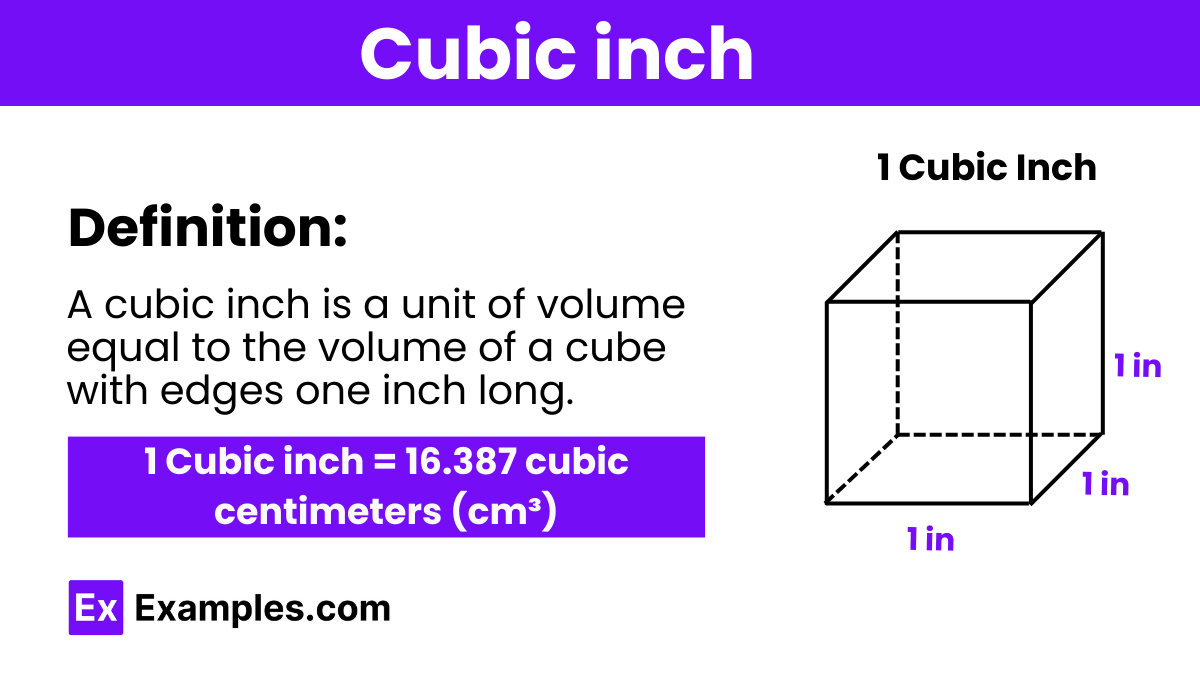What is the volume in cubic inches of a cube with each side measuring 3 inches?
9 in³
18 in³
27 in³
81 in³


A cubic inch is a unit of volume measurement in the Imperial and US customary systems, representing the volume of a cube with sides measuring one inch each. It’s commonly used in engineering, automotive, and manufacturing contexts for small-scale measurements.
The unit of volume for a cubic inch is abbreviated as “in³” or simply “cu in.” It represents the volume of a cube with sides each measuring one inch.
| Shape | Formula |
|---|---|
| Cube | Volume (in³) = Side Length × Side Length × Side Length |
| Rectangular Prism | Volume (in³) = Length × Width × Height |
| Cylinder | Volume (in³) = π × Radius² × Height |
| Sphere | Volume (in³) = (4/3) × π × Radius³ |

| From/To | Conversion factor |
| Cubic inch to Cubic centimeter (cm³) | 1Cubic inch = 16.387 cm³ |
| Cubic inch to Cubic meter (m³) | 1Cubic inch = 0.000016387 m³ |
| Cubic inch to Liter | 1Cubic inch ≈ 0.016387 liters |
| Cubic inch to Milliliter | 1Cubic inch ≈ 16.387 milliliters |
| Cubic inch to Gallon (US) | 1Cubic inch ≈ 0.004329 gallons (US) |
| Cubic inch to Gallon (UK) | 1Cubic inch ≈ 0.003604 gallons (UK) |
One cubic inch equals approximately 16.387 cubic centimeters, commonly used for small-scale volume measurements in engineering and manufacturing.
One cubic inch is equivalent to approximately 0.000016387 cubic meters, a small volume in the metric system.
One cubic inch is equivalent to approximately 0.016387 liters, a common conversion for small-volume measurements in fluid capacity.
One cubic inch is equivalent to approximately 16.387 milliliters, commonly used for precise volume measurements in scientific and engineering contexts.
One cubic inch is equivalent to approximately 0.004329 gallons (US), often used for small-scale volume measurements.
One cubic inch is approximately equal to 0.003604 gallons (UK), making it a small volume measurement in fluid capacity.

Here’s the conversion formula:
Cubic Feet = Cubic Inches/1728
For example, if you have 5,000 cubic inches and want to convert it to cubic feet:
Cubic Feet = 5000/1728 Cubic Feet ≈ 2.893
So, 5,000 cubic inches is approximately 2.893 cubic feet.
To convert cubic inches to cubic centimeters (cm³), you can use the conversion factor that 1 cubic inch is equal to approximately 16.387 cubic centimeters.
Here’s the conversion formula:
Cubic Centimeters = Cubic Inches × 16.387
For example, if you have 10 cubic inches and want to convert it to cubic centimeters:
Cubic Centimeters =10 × 16.387
Cubic Centimeters ≈ 163.87
So, 10 cubic inches is approximately equal to 163.87 cubic centimeters.
Cubic inches find applications in various fields, including engineering, manufacturing, architecture, packaging, cooking, and hobbyist activities. They are used to measure volumes of small-scale objects, materials, and ingredients.
Despite the prevalence of the metric system, cubic inches are still used in certain industries, particularly in the United States and in contexts where legacy measurements are preferred or required by regulations.
Text prompt
Add Tone
10 Examples of Public speaking
20 Examples of Gas lighting
What is the volume in cubic inches of a cube with each side measuring 3 inches?
9 in³
18 in³
27 in³
81 in³
A rectangular box has dimensions of 2 inches by 3 inches by 4 inches. What is its volume in cubic inches?
12 in³
20 in³
24 in³
48 in³
What is the volume in cubic inches of a cylinder with a radius of 2 inches and a height of 5 inches? (Use π≈3.14)
31.4 in³
62.8 in³
94.2 in³
125.6 in³
What does a cubic inch measure?
Area
Volume
Length
Weight
How many cubic inches are there in one cubic foot?
144
432
864
1728
Which of the following is equivalent to one cubic inch?
A cube with sides of 1 inch each
A square with sides of 1 inch each
A cube with sides of 1 foot each
A rectangle with sides of 1 inch each
In which of the following applications would you commonly measure in cubic inches?
Measuring the weight of a person
Measuring the area of a field
Measuring the volume of an engine
Measuring the length of a rope
Which of the following units is larger than a cubic inch?
Cubic centimeter
Cubic millimeter
Cubic foot
Cubic meter
How many cubic centimeters are equivalent to one cubic inch?
1.54
2.54
10.16
16.39
Which of the following best describes the size of one cubic inch?
The size of a sugar cube
The size of a small refrigerator
The size of a large suitcase
The size of a football field
Before you leave, take our quick quiz to enhance your learning!

